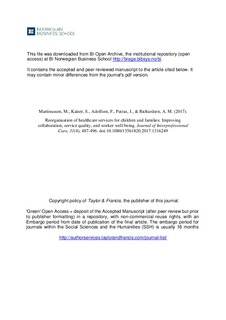Reorganisation of healthcare services for children and families: Improving collaboration, service quality, and worker well-being
Journal article, Peer reviewed
Accepted version
Permanent lenke
http://hdl.handle.net/11250/2477033Utgivelsesdato
2017Metadata
Vis full innførselSamlinger
- Publikasjoner fra CRIStin - BI [1015]
- Scientific articles [2173]
Originalversjon
Journal of Interprofessional Care. 2017, 31 (4), 487-496. 10.1080/13561820.2017.1316249Sammendrag
This study is an evaluation of a reorganisation of different services for children and their families in a Norwegian municipality. The main aim of the reorganisation was to improve interprofessional collaboration through integrating different social services for children and their parents. The evaluation was guided by the Job Demands-Resources Model with a focus on social and healthcare workers’ experiences of their work, including job demands and resources, service quality, and well-being at work. The survey of the employees was conducted at three measurement points: before (T1) and after (T2, T3) the reorganisation took place, and included between 87 and 122 employees. A secondary aim was to examine the impact of different job resources and job demands on well-being (burnout, engagement, job satisfaction), and service quality. A one-way ANOVA indicated a positive development on many scales, such as collaboration, work conflict, leadership, and perceived service quality, especially from T1 to T2. No changes were detected in burnout, engagement, or job satisfaction over time. Moderated regression analyses (at T3) indicated that job demands were particularly associated with burnout, and job resources with engagement and job satisfaction. Perceived service quality was predicted by both job demands and resources, in addition to the interaction between workload and collaboration. The reorganisation seems to have contributed to a positive development in how collaboration, work conflict, leadership, and service quality were evaluated, but that other changes are needed to increase worker well-being. The value of the study rests on the findings that support co-locating and merging services for children and their families, and that collaboration is an important resource for healthcare professionals.
